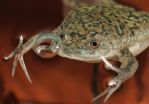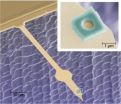(Press-News.org) "Don't be a frog!" people say in jest when someone hesitates instead of acting straight away. However to be called a frog should actually be a reason to strengthen one's self-confidence. After all frogs are real winners – at least from the point of view of evolutionary biology: Nearly 6.000 species are known today. "In terms of numbers frogs are superior to all the other amphibians, and even mammals", says Professor Dr. Lennart Olsson from the Friedrich Schiller University Jena (Germany). Professor Olsson's research group for Systematic Zoology examines these animals's special secret of success. "We are interested in how the frogs developed in such a great variety and which evolutionary new development is responsible for making frogs so particularly successful", Jennifer Schmidt from Olsson's team explains.
Their evolutionary success is literally written all over the frogs' faces: Certain forms of cartilage and bone structures in the region of the head of the tadpoles are among the frogs' "innovations". These structures only to be found in frogs appear in the oral region. They enable the tadpoles – of the South African claw frog (Xenopus laevis) – particularly well to chip vegetarian food from the soil and from stones or to filter it from the water.
In their latest study which has been published in the science magazine "Journal of Anatomy" together with colleagues from Ulm Jennifer Schmidt analysed the central factor for the development of these morphologically distinctive features of the tadpoles. It is well known from earlier analyses, that the gene "FOXN3" plays a key role in the embryonal development of the heads of claw frogs. "It is responsible for the normal development of cartilages, bones and muscles", Jennifer Schmidt explains.
In the newly published study the 25 year old doctoral candidate and scholar of the Konrad-Adenauer-Stiftung analysed larvae of the claw frog after the "FOXN3"-gene had been cut off. Then she compared them with untreated larvae. "Our analyses with microCT show that the larvae without an intact 'FOXN3'-gene are developing normally up to a certain time." But then the development slows down, says Jennifer Schmidt. "On the whole these animals grow more slowly." Most of all the cartilages, the bones and muscles don't develop properly. Deformations and loss of functions occur. However not all cartilages and muscles are affected by the cut-off gene. "We were able to show that the 'FOXN3' most of all influences the development of the cartilages in the oral region and the gills", Professor Olsson points out. These structures in particular belong to the evolutionary new developments typical of frogs, which are missing in other amphibians. Jennifer Schmidt would like to continue her analyses in her thesis. "We are going to compare the embryonal development of the claw frogs with those of other amphibians", the zoologist says. It would be interesting to find out to what extent the genetic control of those new developments changed in the course of the evolution.
INFORMATION:
Original Publication:
Schmidt J, Schuff M, Olsson L: A role for FoxN3 in the development of cranial cartilages and muscles in Xenopus laevis (Amphibia: Anura: Pipidae) with special emphasis on the novel rostral cartilages. J Anat. 2010. doi: 10.1111/j.1469-7580.2010.01315.x.
Contact Details:
Jennifer Schmidt / Professor Dr. Lennart Olsson
Institute for Systematic Zoology and Evolutionary Biology with Phyletic Museum
Friedrich Schiller University Jena
Erbertstr. 1
D-07743 Jena
Phone: ++49 (0)3641 / 949165 or 949160
Email: jennifer.schmidt@uni-jena.de / lennart.olsson@uni-jena.de
Inventions of evolution: What gives frogs a face
Zoologists of the University Jena clarify the role of the gene FOXN3 for the development of the clawed frog
2011-01-14
ELSE PRESS RELEASES FROM THIS DATE:
Is 'breast only' for first 6 months best?
2011-01-14
Current guidance advising mothers in the UK to exclusively breast feed for the first six months of their baby's life is being questioned by child health experts on bmj.com today.
The authors, led by Dr Mary Fewtrell, a consultant paediatrician at the UCL Institute of Child Health in London, have reviewed the evidence behind the current guidance and say the time is right to reappraise this recommendation.
The researchers stress that while they fully back exclusive breast feeding early in life, they are concerned that exclusively doing so for six months and not introducing ...
Taking more steps every day can help ward off diabetes
2011-01-14
Simply taking more steps every day not only helps ward off obesity but also reduces the risk of diabetes, finds a study published on bmj.com today.
While several studies have shown that physical activity reduces body mass index and insulin resistance - an early stage in the development of diabetes - this is the first study to estimate the effects of long-term changes in daily step count on insulin sensitivity.
A popular guideline is to do 10,000 steps every day, though a more recent recommendation is 3,000 steps, five days a week.
The research, by the Murdoch Childrens ...
Virus might fight brain tumors better if armed with bacterial enzyme, study shows
2011-01-14
COLUMBUS, Ohio – New research shows that oncolytic viruses, which are engineered to destroy cancer cells, might be more effective in treating deadly brain tumors if equipped with an enzyme that helps them penetrate the tumor.
The enzyme, called chondroitinase, helps the cancer-killing virus clear its way through the thickets of protein molecules that fill space between cells and impede the virus's movement through the tumor, say researchers at the Ohio State University Comprehensive Cancer Center-Arthur G. James Cancer Hospital and Richard J. Solove Research Institute ...
Enzyme inhibition or removal may prevent or treat ischemic retinopathy
2011-01-14
AUGUSTA, Ga. – The inhibition or removal of an enzyme may prevent or treat ischemic retinopathy by stalling growth of unwanted vessels in the retina, Medical College of Georgia researchers say.
Ischemic retinopathy is characterized by uncontrolled formation of new blood vessels in the retina, and is seen in diseases such as diabetic retinopathy and retinopathy of prematurity. While this blood vessel formation, called neovascularization, can benefit ischemic heart disease and wound healing, it is bad in the retina, where new vessels are dysfunctional and bleed, usually ...
'Longevity' protein SIRT1 may ward off precursor to prostate cancer
2011-01-14
PHILADELPHIA—Researchers from the Kimmel Cancer Center at Jefferson and two other institutions have discovered new evidence that suggests the "longevity" protein SIRT1, known for its life-spanning effects in different species, can inhibit the development of a known precursor to prostate cancer, prostatic intraepithelial neoplasia (PIN).
Results from the study could lead to new cancer prevention drugs that could not only block prostate cancer but promote longevity.
The study, published in the February 1 issue of Cancer Research, found that deletion of the Sirt1 gene ...
Study highlights flaw in common approach of public opinion surveys about science
2011-01-14
A new study from North Carolina State University highlights a major flaw in attempting to use a single survey question to assess public opinion on science issues. Researchers found that people who say that risks posed by new science fields outweigh benefits often actually perceive more benefits than risks when asked more detailed questions.
"We set out to determine whether we can accurately assess public opinion on complex science issues with one question, or if we need to break the issue down into questions on each of the issue's constituent parts," says Dr. Andrew Binder, ...
UT professor helps develop DinEX scale to measure restaurant appeal
2011-01-14
What is it that makes you want to return to a restaurant again and again?
The food? The service? Atmosphere?
Sure.
But according to research spearheaded by John Antun, associate professor in the Department of Retail, Hospitality and Tourism and director of the Culinary Institute at the University of Tennessee, Knoxville, and Robert E. Frash Jr., chair of the HRT department at the College of Charleston (S.C.), there are two more factors that must be added to mix: the social experience and the availability of healthy menu options.
Antun and Frash Jr. collaborated ...
Researchers find rising levels of hypertension in older Mexican-Americans
2011-01-14
GALVESTON, Texas — A new study by researchers at the University of Texas Medical Branch at Galveston reveals that the prevalence of hypertension in older Mexican-Americans living in the Southwest region of the United States has increased slightly in the last decade.
Researchers suspect the rise is due, in part, to the increase in diabetes and obesity.
Although hypertension, or high blood pressure, is one of the most common diseases in the United States, affecting more than 72 million Americans, it is one of the most manageable risk factors for cardiovascular disease. ...
U of I physicists observe exotic state in an unconventional superconductor
2011-01-14
CHAMPAIGN, Ill. - A new fractional vortex state observed in an unconventional superconductor may offer the first glimpse of an exotic state of matter predicted theoretically for more than 30 years. In a paper published in the January 14 issue of Science, University of Illinois physicists, led by Raffi Budakian, describe their observations of a new fractional vortex state in strontium ruthenium oxide (SRO). Such states may provide the basis for a novel form of quantum computing in which quantum information is encoded in the topological properties of a physical system.
"We've ...
MU scientists find new farming method to reduce greenhouse gases, increase farm yields
2011-01-14
COLUMBIA, Mo. – U.S. agricultural practices create 58 percent of nitrous oxide in the world, which is the third most prevalent greenhouse gas in the atmosphere. Scientists believe nitrous oxide contributes to global warming about 300 times more than carbon dioxide. New practices and products have been introduced to address this issue, but farmers do not have the time or profit margins to experiment with ideas that may ultimately hurt the "bottom line." Now, researchers at the University of Missouri have found methods to help farmers reduce those emissions while also increasing ...
LAST 30 PRESS RELEASES:
Injectable breast ‘implant’ offers alternative to traditional surgeries
Neuroscientists devise formulas to measure multilingualism
New prostate cancer trial seeks to reduce toxicity without sacrificing efficacy
Geometry shapes life
A CRISPR screen reveals many previously unrecognized genes required for brain development and a new neurodevelopmental disorder
Hot flush treatment has anti-breast cancer activity, study finds
Securing AI systems against growing cybersecurity threats
Longest observation of an active solar region
Why nail-biting, procrastination and other self-sabotaging behaviors are rooted in survival instincts
Regional variations in mechanical properties of porcine leptomeninges
Artificial empathy in therapy and healthcare: advancements in interpersonal interaction technologies
Why some brains switch gears more efficiently than others
UVA’s Jundong Li wins ICDM’S 2025 Tao Li Award for data mining, machine learning
UVA’s low-power, high-performance computer power player Mircea Stan earns National Academy of Inventors fellowship
Not playing by the rules: USU researcher explores filamentous algae dynamics in rivers
Do our body clocks influence our risk of dementia?
Anthropologists offer new evidence of bipedalism in long-debated fossil discovery
Safer receipt paper from wood
Dosage-sensitive genes suggest no whole-genome duplications in ancestral angiosperm
First ancient human herpesvirus genomes document their deep history with humans
Why Some Bacteria Survive Antibiotics and How to Stop Them - New study reveals that bacteria can survive antibiotic treatment through two fundamentally different “shutdown modes”
UCLA study links scar healing to dangerous placenta condition
CHANGE-seq-BE finds off-target changes in the genome from base editors
The Journal of Nuclear Medicine Ahead-of-Print Tip Sheet: January 2, 2026
Delayed or absent first dose of measles, mumps, and rubella vaccination
Trends in US preterm birth rates by household income and race and ethnicity
Study identifies potential biomarker linked to progression and brain inflammation in multiple sclerosis
Many mothers in Norway do not show up for postnatal check-ups
Researchers want to find out why quick clay is so unstable
Superradiant spins show teamwork at the quantum scale
[Press-News.org] Inventions of evolution: What gives frogs a faceZoologists of the University Jena clarify the role of the gene FOXN3 for the development of the clawed frog


